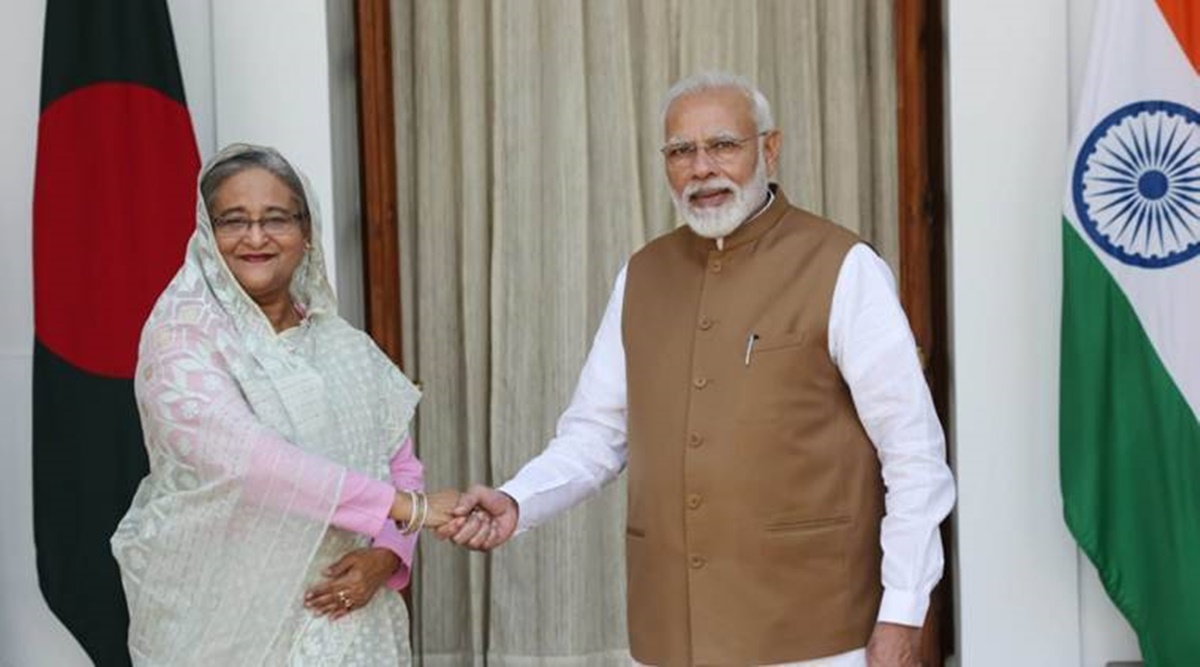 A file photo of Bangladesh PM Sheikh Hasina with Prime Minister Narendra Modi. (Express Photo by Tashi Tobgyal)
A file photo of Bangladesh PM Sheikh Hasina with Prime Minister Narendra Modi. (Express Photo by Tashi Tobgyal)Even as Sheikh Hasina prepared to board the Biman flight to Delhi, a journey which could well be her last as the prime minister of Bangladesh, India has a surfeit of reasons to be grateful to Bangabandhu’s daughter. After all, during the last 13 years, Hasina acted against fundamentalists and war criminals in her country that were not only threatening the secular character of Bangladesh but were rabidly anti-India.
She also ably led the crackdown on Indian insurgents that were operating from Bangladesh. Hasina undertook the task despite the ambivalence — and even resistance — that continues to characterise a section of the Bangladesh army and the DGFI to act against a “station” that they had inherited from the “Islamist backed barrack politics” system that was governing erstwhile East Pakistan for several decades.
One of the unqualified successes of Hasina’s crusade against the 1971 war criminals was the executions of several Rajakars including Salahuddin Quader Choudhury, Abdul Quader Mollah and Motiur Rahman Nizami who had not only aided the Pakistan army in its pogroms during the run-up to the War of Liberation, but had also committed atrocities against the Hindu population of Bangladesh.
If history is to be briefly resurrected, Choudhury was responsible for—among other crimes—the massacre of an entire village of Hindus in Patia on June 16, 1971, and Mollah for killing 344 people and raping an 11-year-old girl. The popular outrage against the war criminals was so pronounced that a protest was engineered in Dhaka’s Shahbag Square in February 2013, which called for altering the sentence of life imprisonment to execution for Mollah and for the banning of the Jamaat-e-Islami.
However, despite the fact that the word “genocide” is used by scholars to describe the events that led up to the 1971 war, the allegation that genocide actually took place during the Bangladesh War of 1971 was never probed by an international tribunal. This was primarily due to the partisan role of the United States at the time, which was clearly not in favour of the severance of Pakistan. Pakistan’s role both in the genocide and its continuing subterfuges against India inside Bangladesh is a proven fact. However, the primary concern of the present pertains to the anti-India role that China is playing in Bangladesh. This is so notwithstanding the “balancing act” that Hasina has been able to conjure up between the two Asian giants.
One aspect of Bangladesh’s socio-cultural polity that is generally not understood is the schism that continues to characterise the secular Bangladeshi, who is secured to the concerns of Bengali linguistic nationalism and the one who identifies oneself with the religious overtones of Pakistani irredentism, and even with radical Salafism that has caught the imagination of puritanical elements among certain Muslims. Analysis must take into consideration the difference in the milieu that propels Bangladesh’s demography and consequently, its politics.
Two distinct social groupings make up Bangladesh. One constitutes the Ashrafis or the north Indian Muslims of Turko-Persian or Arab origins that came and settled in Bengal but have retained their up-country culture. The other constituency comprises the Atrabis, who are Bengalis, mostly lower-caste Hindus who converted to Islam. The Ashrafis were the people who were extremely enthusiastic about Pakistan, and were consequently used by the latter between 1947-71. The Atrabis, on the other hand, were loyal to their Bengali identity and continues to practise Hindu customs like applying turmeric on the bride’s body during a pre-marriage ceremony and observing Poila Boisakh (Bengali New Year). It is this constituency that supports the Awami League and is a strong votary for Bengali linguistic nationalism. AK Fazlul Huq, who was the first and the longest premier of Bengal during British India, was an Atrabi. He even supported Hindu Mahasabha president Syama Prasad Mookerjee. The colonial rulers removed Huq and foisted a Jinnah protégé (an Ashrafi) Hassan Shaheed Suhrawardy. Huq’s keenness and efforts to create a united Bengal (meeting with Sarat Bose until the end of July 1947 to shore up the attempt) are well-documented facts. The tale of two Bangladeshs is, therefore, not a figment of imagination.